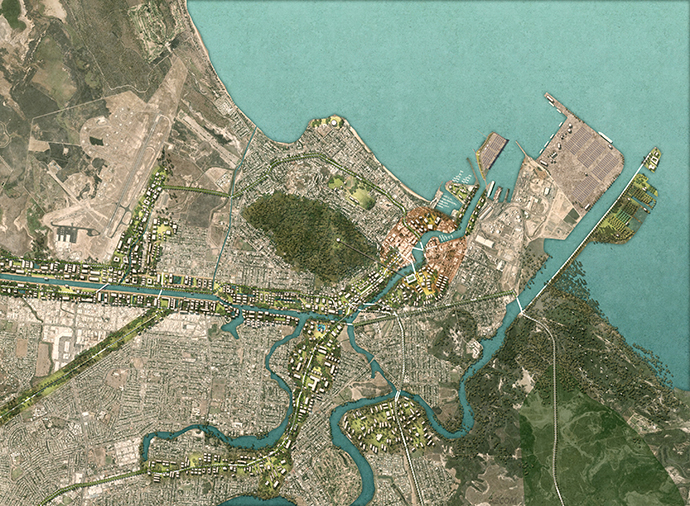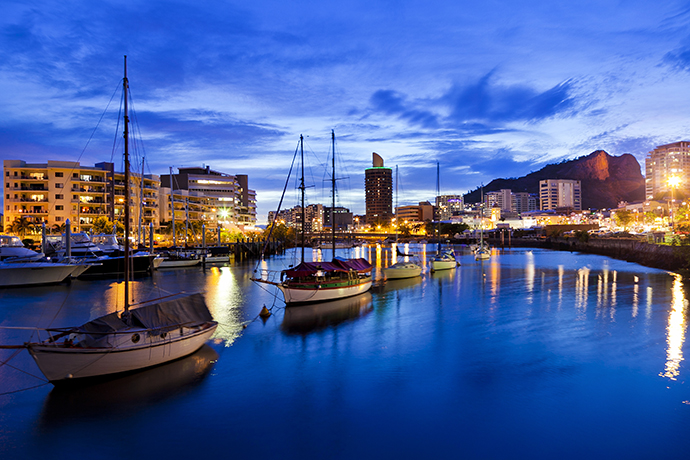Townsville 2100: turning risk into resilience
AECOM’s Design + Planning practice in Australia recently responded to a challenge issued by Townsville Enterprise: “Imagine Townsville as a metropolitan landscape of millions.”
For those not familiar with the city, Townsville is a well-established and distinctive regional centre half way up the eastern coast of Queensland. As the ‘capital’ of North Queensland, it is located in the dry tropics, with an exceptional setting to the west of Cleveland Bay on the edge of the Coral Sea. The city is framed by the distinctive topography of the iconic Castle Hill, Magnetic Island and surrounding ranges.
Photo by Megan MacKinnon.
The current population is c.189,000. The growth trajectory even to the first million is therefore a leap of some 520 percent. This is huge by any standards, so questions therefore focus upon ‘how?’ and ‘when?’ How would the growth be supported? In light of that, when could that population threshold be achieved? What would Townsville’s growth over that period mean for the region generally, and what would national growth over the same period offer Townsville?
Here was a challenge that blended thinking far into the future with our established understanding of Townsville today. In response to the challenge we established a loose think tank to capture a potent blend of local knowledge, innovative ideas and international experience.
The current population of Townsville is spread like warm butter. City density is low. Despite the exceptional setting and climate, the city suffers from what could be described as cultural dilution. Beginning with the CBD, a more concentrated focus therefore has real potential to quickly establish energetic centres for growth, with the ability to create more diverse opportunities and significantly increased amenity for the existing community.

The format of the city reveals the framework for growth. The regional airport is close to the CBD. The CBD is very compact and currently straddles the neglected Ross Creek setting with a wonky gait. Established commerce, research, administration and industry – combined with a policy shift towards regional decentralisation from the south east – provide the platform for economic growth. The hospital and James Cook University sit on the southern edge of the city, but within range of a better-connected urban environment.
Our focus became Townsville in 2100. This kind of timescale meant big issues had to be addressed. After all, this is tropical cyclone country; the flood risk from a coastal storm surge is already significant. Townsville is a strategic location for defence, for transportation, agriculture and for cyclone recovery. The projected re-shaping of the coast due to incremental sea level rise means that ‘no change’ for the city is not a viable option.
At this scale it is possible to embrace challenges as opportunities because integrated large-scale infrastructure can be anticipated as multi-functional layers within the enhanced growth framework. This is a game-changing viewpoint for the exercise. With an integrated strategic view of the future, many things that are normally too hard to imagine become tangible and transformational. Large elements can be defined as the setting for finer-grained development. Of equal importance, we can consider the cost and value of big changes for a growing city over a much longer timeframe.
A key objective was enhancing Townsville’s existing assets. With an ambitious view of Townville’s future we defined a canal system as part of a network of waterways for flood mitigation. Tidal flows were harnessed for flushing, energy production and for aquaculture. This all taps into the local setting, climate and an established research focus to establish a sustainable approach – harnessing existing potential. The canals then became distinctive and valuable aqua-boulevards, carrying people, connecting places and cooling the environment. Solar farming and research-based living systems created symbiotic links for urban food production, water security and economic diversity within mid-density growth. As a development of the existing place, Townsville in 2100 becomes the water capital of the dry tropics. The risk has become the opportunity.
It’s easy to forget that we know a great deal about making sustainable urban environments to promote and enhance future health and well-being. Whilst this is a glimpse of a possible future, there is something compelling about an integrated multi-disciplinary approach to big-picture thinking. The opportunities and advantages of future growth were simply aligned as layers over the strategic framework.
It’s intriguing that councils are keen to know more about how the future may look. This need not be crystal ball gazing. We should have the confidence to assert the potential of this approach and to engage with others to explain and explore real solutions that can unlock latent potential. We should also recognise the process starts with innovative and imaginative strategic thinking, today.
The primary test: could I see myself embracing this vision and joining the growing population of Townsville? Yes, I could. The most important thing now is ensuring that an ambitious and strategic framework is embraced to create a series of distinctive and concentrated Townsville flavours to claim the future we have glimpsed.
 Alastair Leighton (alastair leighton) is an associate director with AECOM’s Design + Planning practice in Queensland.
Alastair Leighton (alastair leighton) is an associate director with AECOM’s Design + Planning practice in Queensland.







